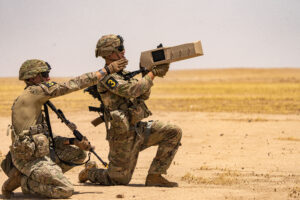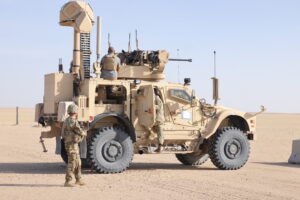
The Threat Moves Fast. Your Strategy Has to Move Faster.
The counter-unmanned aerial system (C-UAS) threat landscape shifts monthly, if not weekly. Tactics and the technology to support them evolve in unforeseen ways, driven by battlefield necessity. What worked six months ago might not work tomorrow. Cheap, adaptable drone systems are rewriting the rules of modern warfare – at scale.
As a result, the Department of Defense (DoD) is pouring resources into C-UAS. But more money doesn’t guarantee better outcomes. Without holistic acquisition models that can keep up with the threat and fast-changing operational needs, acquirers risk buying stuff without strategy.
At Dcode, we’ve supported C-UAS acquisition strategy alongside program leaders in the thick of this challenge. What we’ve delivered isn’t just about C-UAS. It’s about building acquisition for mission needs that change faster than the plan.
Forget Silver Bullets. Design for Change.
C-UAS has made one thing clear: there’s no perfect system. Directed energy, electronic warfare (EW), kinetic approaches: each has a place. But none solve the problem alone. And with new modalities appearing all the time, rigid acquisition cycles can’t keep up.
Winning strategies prioritize adaptability:
- Segmented vendor pools that let testing, learning, and fielding happen in parallel
- Non-traditional buying models (such as OTA and CSO) that reduce friction in bringing in emerging players
- Hardware-software decoupling, especially critical as systems become increasingly software-defined
- Performance-based contracts that prioritize results, not just spec
Adaptability isn’t chaos. It’s structure designed for change.
Make Risk and Tradeoffs Visible
We’ve seen acquisition teams move faster, and with more confidence, when they use course of action (COA) planning up front. Not just to lay out options, but to force real conversations about priorities and tradeoffs.
A good set of COAs doesn’t just show a path; it surfaces priorities. Are we optimizing for speed? Cost? Risk tolerance?
In our C-UAS work, this framing is essential. By presenting multiple COAs, each with a different approach to technology sourcing, risk posture, and operational impact, stakeholders across S&T, ops, and contracting come to the table with a shared lens – and make decisions with strategic clarity.
This approach is a decision accelerator – making the invisible visible, and helping teams choose a path that reflects the mission they’re solving for.
Modularity Isn’t Just a Tech Term
C-UAS systems are modular by necessity – sensors, shooters, and software all evolving at different speeds. But unless acquisition is equally modular, the system stalls.
That means rethinking acquisition, funding, and integration:
- Enabling vendor competition at the level of modularity, so faster-maturing subsystems aren’t delayed by slower ones, with interoperability enforced through clear interfaces and testable outputs.
- Letting operational needs, not contract timelines, drive system development, integration, and updates.
This is where software-defined capability becomes critical. If you can integrate and control the system in software, you can afford to iterate parts more flexibly. That gives you the confidence to relax rigid procurement timelines and loosen sustainment constraints, without losing coherence in the field.
But modularity in tech only delivers if you have fiscal agility to match. That means:
- Rapid reallocation between budget lines as operational needs shift.
- Obligation strategies that fund what’s ready now, without waiting on annual resets.
- Contracting approaches that treat agility as a requirement, not a risk.
You can’t build dynamic systems with static structures. The current state of C-UAS shows that if you want flexibility at the edge, you need modularity not just in hardware and software, but in the process, the money, and the mindset.

What Good Is Capability Without Clarity?
Which brings us back to where we started: a fast-changing landscape, dozens of supposed answers from dozens of vendors, and the real sense that we are not ready.
Regardless of how much of this C-UAS equipment is formally authorized in the TO&E, when the drone swarm appears on radar, operators need to know who fires what, and when – and the various systems have to cohere to produce effects that matter, with no gaps, shortcomings, or latency.
This is where strategy meets doctrine. Without cross-functional alignment – between acquisition, policy, requirements, and doctrine – you get fragmentation. Not just across services, but often within them.
Dcode’s role has been to help teams align competing needs – especially within services where acquisition authorities, requirements writers, and operational users may not align by default – to bridge the gap between the speed of technology and the need of the mission.
The Acquisitions Playbook Applies Across Technology Domains.
We talk about C-UAS because it’s urgent. But the playbook applies broadly.
Every fast-evolving mission area needs:
- Clear decision frameworks, from tech discovery to fielding
- Alignment across DOTMLPF dimensions (even when only a few are in scope)
- Agile evaluation and fielding models
- Structures that make policy and operations part of acquisition, not afterthoughts
This isn’t just about getting the next drone-killer on contract. It’s about building acquisition approaches that actually get capability to the fight.
The Time to Address the Threat is Now.
We’re helping programs and mission owners across the government build acquisition strategies that meet the moment. Not just faster, but smarter. Not just adaptive, but operationally grounded.
If your team is wrestling with fragmented C-UAS efforts, or any capability where the threat is outpacing the process, we’re here to help you move. Learn more and contact us at dcode.co/cuas.
The appearance of U.S. Department of Defense (DoD) visual information does not imply or constitute DoD endorsement.

